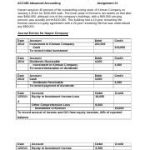Content

You’re preparing to close the books for the year ended December 31, 2011. You post totals from the journals to the general ledger, and foot the general ledger accounts. Then you prepare the following preliminary trial balance, using the balances from your general ledger accounts.
Johnson provides early Daytona thrills in NASCAR comeback – Columbus Ledger-Enquirer
Johnson provides early Daytona thrills in NASCAR comeback.
Posted: Sat, 18 Feb 2023 17:49:13 GMT [source]
Adjusting entries and closing entries, made at the end of an accounting period, are the most common entries made in the general journal. The general journal is also used to record special transactions that don’t get recorded in one of the regular journals. After tracking down and correcting any trial balance errors, you are ready to prepare a balance sheet and an income statement.
Format of a Standard Ledger Account
Banks and other financial institutions are examples of business organizations that use self-balancing ledger accounts. These accounts illustrate journal and ledger entries in the examples below In reality, of course, the full chart of accounts, journal, and ledger will include many others not shown here. However, for one week’s activity affecting these accounts, the journal and ledger entries might appear as the following section shows.
- The cost of sales is subtracted from that sum to yield the gross profit for that reporting period.
- It provides a permanent and classified record of every element in the business operation.
- This section further describes the ledger’s role in several steps of the accounting cycle.
- Enter the object account and, if applicable, the subsidiary.The system uses this AAI item for automatic sign reversal and to calculate the percentage of revenue on some reports.
GLs generate a number of important What is a Ledger Account? The Rules Working with Ledger Accounts statements for various internal stakeholders. They can use the financial information provided in those statements when making business decisions. Reconciliation is an accounting process that compares two sets of records to check that figures are correct, and can be used for personal or business reconciliations. The trial balance is a report that lists every general ledger account and its balance, making adjustments easier to check and errors easier to locate. A ledger account is a record of all transactions affecting a particular account within the general ledger. You might need to review, track, and report on information about a business unit that is not included in the standard master tables. This type of information is referred to as supplemental data.
Accounts in a general ledger
If at any point the sum of https://personal-accounting.org/s for all accounts does not equal the corresponding sum of credits for all accounts, an error has occurred. It follows that the sum of debits and the sum of the credits must be equal in value. Double-entry bookkeeping is not a guarantee that no errors have been made—for example, the wrong ledger account may have been debited or credited, or the entries completely reversed. For example, if the amount in Figure 3 was the final balance in the cash account it would be listed on the trial balance with the debit column because it is in the debit column in the general ledger.
What are the two basic rules for posting to the ledger?
Rules of posting in the General ledger
The amount shown on the credit side in the journal must be posted on the credit side of the general ledger. The amount shown on the debit side in the journal must be posted on the debit side of the general ledger.
Instead, financially-minded individuals — and businesses — use ledgers to fastidiously document money that’s they’re paying out, or being paid. What is Factoring and its Importance in Financial Management? Factoring is a practice in which a company buys the accounts receivable of another company at a dis… This article has been prepared on the basis of internal data, publicly available information and other sources believed to be reliable. The information contained in this article is for general purposes only and not a complete disclosure of every material fact.
What Is the Purpose of a General Ledger?
Account journals have much similar information as the ledger. You can understand them as drafts, and the ledger as a reasonable copy of your monetary documents. You may not regulate or follow the proper format for transactions in the journal, which you adjust when you develop them to the ledger.
The general ledger is just like a book where certain rules are defined to record the financial transaction of an entity so that it will give the financial position of the entity at any point in time. In contrast, the accounts that feed into the balance sheet are permanent accounts used to track the ongoing financial health of the business. The general ledger functions as a collective summary of transactions posted to subsidiary ledger accounts, such as cash, accounts payable, accounts receivable and inventory. A GL also provides financial accounting records for all of an organization’s business transactions and account balances. These records and the financial data they contain can help accountants spot unusual, erroneous or fraudulent transactions.
